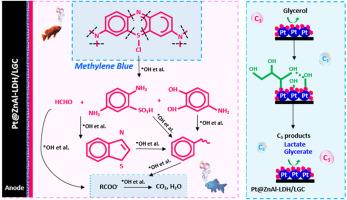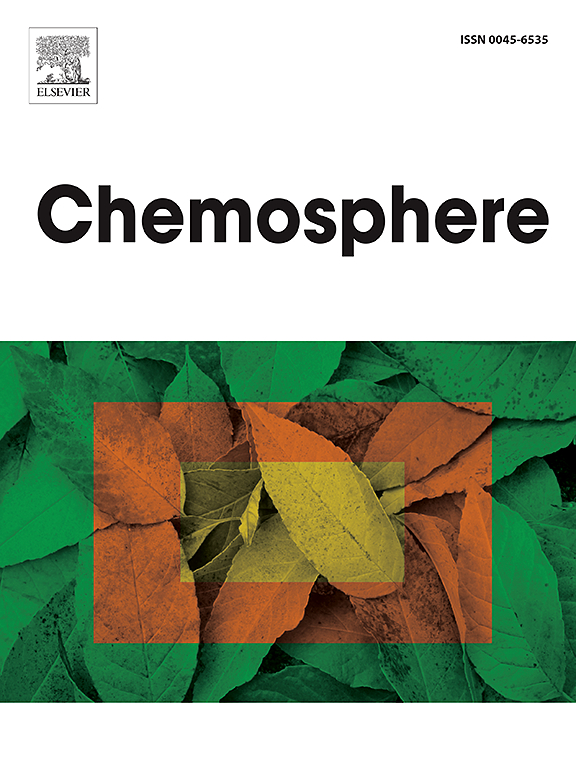3D Pt@ZnAl-LDH catalyst on low-grade charcoal: A novel electrochemical platform for efficient textile dye degradation and glycerol oxidation
IF 8.1
2区 环境科学与生态学
Q1 ENVIRONMENTAL SCIENCES
引用次数: 0
Abstract
The development of sustainable and efficient electrochemical processes is crucial for addressing global challenges related to water scarcity. In this study, we present a novel 3D core-shell electrocatalyst, Pt@ZnAl-LDH, supported on low-grade charcoal (LGC), which exhibits exceptional electrocatalytic activity for the degradation and decolorization of dye and the electrocatalytic conversion of glycerol to valuable C3 chemicals. The electrocatalytic degradation of methylene blue dye from water was investigated with a focus on the impact of temperature, pH, and dye concentration. The Pt@ZnAl-LDH/LGC anode demonstrates high selectivity for converting glucose into lactate and other C3 products, achieving an impressive 85% conversion rate at 0.5 V vs. Furthermore, the electrode achieves an exceptionally high level of selectivity for C3 products, reaching 86% at 2.2 V vs, significantly outperforming other electrodes. Theoretical calculations and electrochemical in situ techniques reveal that the incorporation of ZnAl-LDH enhances the adsorption of hydroxyl species, leading to improved glucose oxidation reaction performance. The 3D Pt@ZnAl-LDH/LGC catalyst optimizes glycerol adsorption, preventing the formation of unwanted intermediates and ensuring high activity and selectivity for C3 products. This work presents a novel electrocatalytic compound for the degradation of toxic dyes and the production of valuable C3 products using an inexpensive aqueous glucose oxidation method.

低级木炭上的 3D Pt@ZnAl-LDH 催化剂:高效纺织染料降解和甘油氧化的新型电化学平台。
开发可持续的高效电化学工艺对于应对与水资源短缺有关的全球性挑战至关重要。在本研究中,我们提出了一种新型三维核壳电催化剂 Pt@ZnAl-LDH,该催化剂以低级木炭(LGC)为支撑,在染料降解和脱色以及甘油电催化转化为有价值的 C3 化学品方面表现出卓越的电催化活性。研究了水中亚甲基蓝染料的电催化降解,重点关注温度、pH 值和染料浓度的影响。Pt@ZnAl-LDH/LGC 阳极在将葡萄糖转化为乳酸和其他 C3 产物方面表现出很高的选择性,在 0.5 V vs 时达到了令人印象深刻的 85% 转化率。此外,该电极对 C3 产物的选择性也非常高,在 2.2 V vs 时达到了 86%,明显优于其他电极。理论计算和电化学原位技术表明,ZnAl-LDH 的加入增强了对羟基的吸附,从而改善了葡萄糖氧化反应的性能。三维 Pt@ZnAl-LDH/LGC 催化剂优化了甘油的吸附,防止了不需要的中间产物的形成,确保了 C3 产物的高活性和选择性。这项研究提出了一种新型电催化化合物,可利用廉价的水性葡萄糖氧化法降解有毒染料并生产有价值的 C3 产品。
本文章由计算机程序翻译,如有差异,请以英文原文为准。
求助全文
约1分钟内获得全文
求助全文
来源期刊

Chemosphere
环境科学-环境科学
CiteScore
15.80
自引率
8.00%
发文量
4975
审稿时长
3.4 months
期刊介绍:
Chemosphere, being an international multidisciplinary journal, is dedicated to publishing original communications and review articles on chemicals in the environment. The scope covers a wide range of topics, including the identification, quantification, behavior, fate, toxicology, treatment, and remediation of chemicals in the bio-, hydro-, litho-, and atmosphere, ensuring the broad dissemination of research in this field.
 求助内容:
求助内容: 应助结果提醒方式:
应助结果提醒方式:


